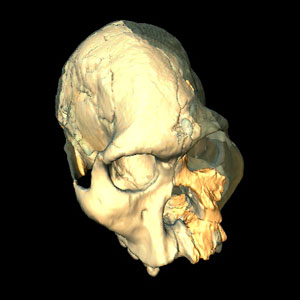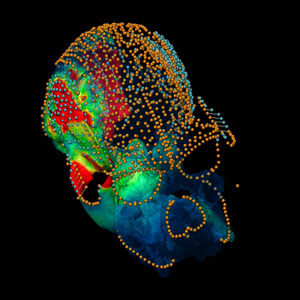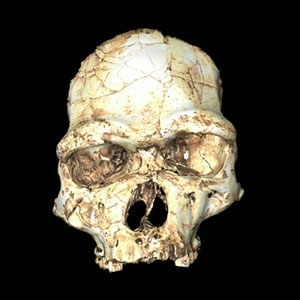
|
Building A Virtual Skull
|
|
|
|
|

Australopithecus africanus (Spec. STS71) Adult male, South Africa; 3.3–2.5 million years. |
WHY BUILD A MODEL?
Fossil skulls are rarely found intact. More often, they’re found crushed, cracked, or broken into pieces that have become separated from one another. Anthropologists can repair the ravages of time, however, by reconstructing fossils using virtual technology. The process of virtual reconstruction begins when scientists make a detailed scan of the fossil and then use a computer to adjust what’s there and fill in what isn’t. After generating one or more possible reconstructions, researchers can use a 3-D printer to sculpt the resulting models in plastic resin. Unlike the original fossil, the resin replicas can be safely handled, transported, and shared. |
|
|
|

Scanning a fossil skull in a CT Scanner |
|
|
CT SCANNING
To make a virtual model of a skull, scientists use CT scanners—the same type of imaging equipment hospitals use. As the skull rotates on a platform, the scanner takes a series of X-ray images. These image “slices” are then stacked to make a 3-D whole. If a fossil is too delicate or valuable to transport, the scanner can be packed up and brought to the fossil instead. |
|
|
|
|

Australopithecus africanus (Spec. STS71) Adult male, South Africa; 3.3–2.5 million years. |
REPLACING MISSING PIECES
Once the fossil has been scanned, researchers begin the reconstruction by identifying “landmarks”—specific features on the fossil such as the outer edge of the eye socket or the small hole in the jaw through which a nerve once passed. Using these landmarks, researchers can repair or rebuild as necessary—replacing a missing cheekbone, repositioning a shattered nasal bone, even experiment with morphing one skull into another. |
|
|
|

(“Tautavel Man,” Spec. Arago XXI) Young adult male, Arago Cave, Tautavel, France; 450,000 years. |
UNDOING DAMAGE
In the case of this particular skull, virtual reconstruction helped clear up a case of mistaken identity. As it fossilized a half-million years ago, this skull was crushed by overlying rock, which squashed the bony ledge over the eyes, called the brow ridge. The distortion caused anthropologists to misclassify the fossil as a much earlier hominid. Recently, the skull was scanned and virtually reconstructed. As part of the reconstruction, researchers were able to virtually “unsquash” the brow ridge, and in so doing reveal the owner’s true identity—a more modern hominid known as Homo heidelbergensis. |
|
|
|

Sequential stills from animation of aging process Australopithecus africanus (“Taung Baby”) Child 4–8 years, South Africa; 3.3–2.5 million years. |
|
|
CREATING VARIATIONS
With an entire library of virtual skulls, anthropologists can do even more than reconstruct individual skulls. They can also make comparisons, composites, or even “cross-breed” two skulls from different species. For example, this animated series shows a reconstruction of the aging process for a 2.5-million-year-old Australopithecus africanus. The skull morphs from baby to adult, revealing how the skull of this particular species may have changed as it matured. |
|
|
|
|
|
Images courtesy:
Philippe Gunz| Research Scientist, Evolutionary Anthropology Max Planck Institute for Evolutionary Anthropology |
|